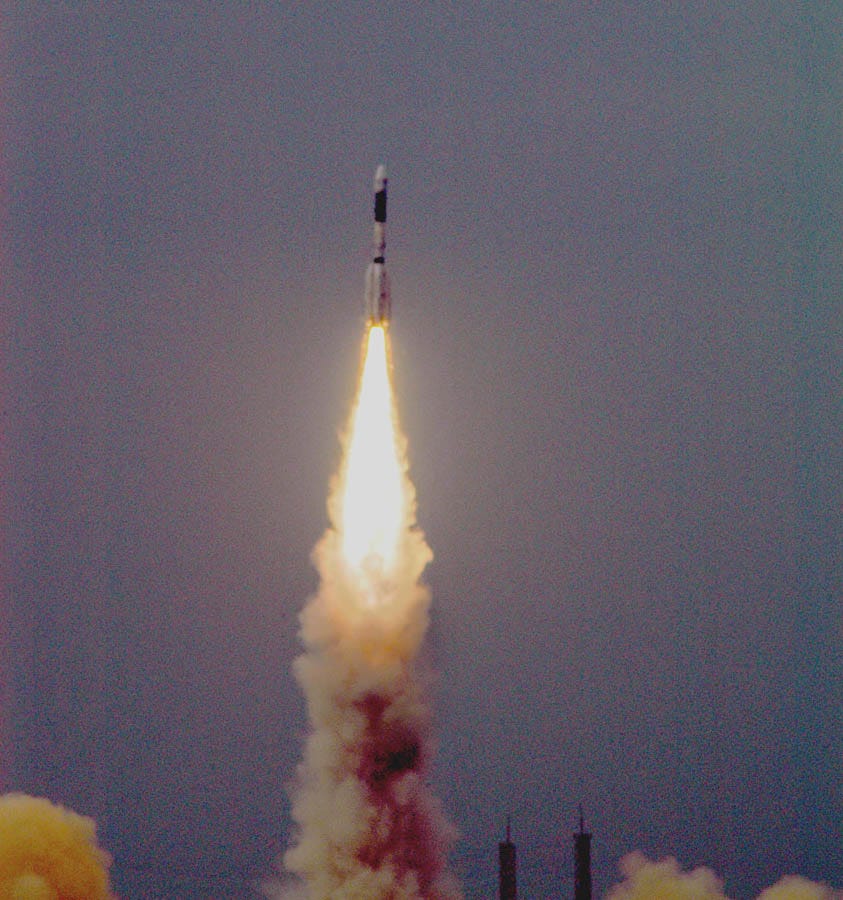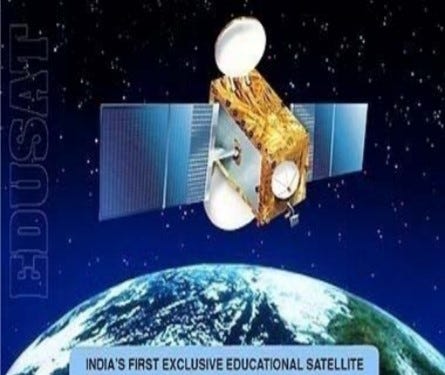EDUSAT: A case-study in Spacecraft Mission Management
EDUSAT, India's first dedicated education satellite launched in Sept 2004 onboard GSLV-F01, served as a learning opportunity in Spacecraft Mission Management.
Indian Education System is limited in its resources. The high population means there is a considerable need for support. The father of the Indian Space Programme, Vikram Sarabhai, saw this need long back and envisioned the Satellite Instructional Television Experiment (SITE). In 2004, ISRO launched the first dedicated education satellite, EDUSAT. This week we celebrate 16 years of the launch and ten years since its retirement. Learn more about the satellite, which tried to strengthen educational infrastructure in the country, EDUSAT launched onboard GSLV-F01. The whole mission can be termed as a case study for planning and executing a multi-agency national mission.
The Spacecraft
EDUSAT was a communication satellite and is also known as GSAT-3. It was the first dedicated tele-education satellite of India, which provided two-way communication to classrooms.
Mass: 1950.5 Kg (Lift-Off) & 819.4 (Dry Mass)
Bus: I-2K (I-2000)
Payload:
Six upper extended C - band transponders
Five lower Ku band transponders with regional beam coverage
One lower Ku band National beam transponder with Indian mainland coverage
Ku beacon
12 C band, high power transponders with extended coverage, covering southeast and northwest region apart from the Indian mainland using 63 W radiatively cooled Ku-band Travelling Wave Tube Amplifiers
Antenna: Multiple spot beam antenna with 1.2 m reflector
Thermal: Dual-core bent heat pipe
Power: Total four solar panel of size 2.54 M x 1.525 M generating 2040 W (End Of Life), two 24 AH NiCd batteries for eclipse support
Stabilization: Three-axis body stabilized in orbit using sensors, momentum and reaction wheels, magnetic torquers, and eight 10 N & 22N reaction control thrusters
Propulsion: 440 N Liquid Apogee Motor (LAM) with MON - 3 and MMH for orbit raising
Launch:
GSLV's first operational flight, GSLV-F01, launched EDUSAT (GSAT-3) on September 20, 2004, from SHAR, Sriharikota, India. The satellite, initially placed in Geo-Transfer Orbit (GTO), was later shifted to Geostationary (74°E longitude) orbit using the LAM motor.
Mission Life: 6 Years
EDUSAT Utilisation Programme
In 2002, ISRO/ Department of Space made the first proposal for a dedicated exclusive education satellite during a meeting with the Space Commission and Ministry of Human Resources Development. The following factors formed the basis for the recommendation:
An acute shortage of qualified teachers both at the school level and higher education, including engineering and other technical subjects.
A massive drop out of students at the school level.
A need for formal and non-formal and continuing education to the vast masses of the country through satellite, viz., EDUSAT given an enormous population of illiterates and rural literacy.
Need to supplement curriculum-based teaching, provide practical teacher training, facilitate community participation, and enable interaction between scholars and research.
Need to provide a quantum jump in providing access to education to remote areas and improving education quality.
Subsequently, in August 2002, the Space Commission approved Rs 85 crore's budget to develop an exclusive education satellite. However, to harness the true potential of the satellite, a network was to be developed. This EDUSAT network would have a hub and studio facility at state capital/designated place of users, Satellite Interactive Terminals (SITs) at universities/colleges, and Receive Only Terminals (ROTs) at schools. Establishing all this ground hardware demanded a separate allocation of resources. Therefore, the Space Commission established the EDUSAT Utilisation Programme (EUP) with a Rs 98 crore budget.
EDUSAT Utilisation Programme (EUP) was to be utilized by various national and regional users. The national users were to be Indira Gandhi National Open University (IGNOU), National Council of Education Research and Training (NCERT), Integrated Disease Surveillance Programme (IDSP), and National Council of Science Museums (NCSM). The regional users were to be state governments, universities, colleges, and schools. ISRO established the national ground network and also provided one hub and ten terminals to each State/Union Territory free of cost.
Objectives of EUP
The EUP was established with long-term goals in mind. Even after the decommissioning of EDUSAT in 2010, EUP still worked with networks shifted to other satellites. In September 2011, there were 47 hubs available in EUP. One hub was capable of supporting eight networks. These networks could support a maximum of 500 SITs, primarily for universities/colleges, and many ROTs, mainly to schools. Therefore, EUP could support 376 networks, and in turn, 1.88 lakh SITs and any number of ROTs. The following were the objectives of EUP.
To provide support to education through the low-cost ground segment and reach the unreached people of India in every nook and corner
To provide sustainable distance education service and support formal and non-formal education in India
Three Phases of EDUSAT Utilisation Programme (EUP)
Department of Space organized the EUP in three phases. These were the pilot phase, semi-operational phase, and operational phase. INSAT 3A/3B satellites were used in the pilot phase to ensure that the technology worked with a satellite-based solution. In the semi-operational phase, EDUSAT was used to establish national and regional networks. In the operational phase, the users were to procure ground segments with technical support from ISRO, and the network was to become fully functional.
Lacks and Recommendations for Further Missions
EDUSAT Utilisation Programme had many issues and lacked in some significant aspects. A 2013 union audit report listed all these shortcomings with recommendations to ISRO for further missions. The report is over 35 pages long, listing all the lapses won't be feasible for this article. I will, therefore, list major recommendations of the audit.
Issues in Planning of EUP
Lapses:
There were issues in the planning phase itself. ISRO did not fix the target dates and action plans for the establishment of the ground network. The dates for the start and end of the three phases were not decided, nor were fixed number of hubs established in each phase. The plan of action for running educational programs was also inadequate.
Recommendation:
DOS/ISRO need to plan their satellite-based application programs only after ensuring that definite plans in terms of finances and infrastructure are in place to fully utilize the satellites.
Issues in Execution of EUP
Lapses:
As opposed to the operationalization of ground networks in March 2005 (6 months after the launch), there was a delay in establishing ground networks in at least 14 states. Overall these delays resulted in a considerable underutilization of EDUSAT capacity. There was a massive disparity in allotment of satellite capacity amongst states for both colleges & schools. Even thefts for the free hardware given by ISRO were reported. A full-time education program channel would require 6,570 educational programs per year with three repeat programs at a rate of 18 hours a day. Inadequate planning resulted in deficiencies of content generation as well.
Recommendations:
In satellite-based application programs wherein stakeholders other than DOS/ ISRO were to be involved, DOS/ISRO may constitute a management structure to sort out issues that would come up during the program's implementation.
ISRO should allocate bandwidth to all users most objectively and transparently to avoid differential treatment and subjectivity in bandwidth allocation.
ISRO also needs to impress upon users to improve bandwidth utilization by creating an appropriate management structure so that the precious national resource is utilized optimally for the benefit of unreached masses and the rural population.
Deficiencies in replacement planning of EDUSAT
Lapses:
EDUSAT was decommissioned in September 2010, due to power constraints on the satellite. This failure resulted in shortening the satellite's mission life from seven (2011) to only six years. But, ISRO had planned replacement to EDUSAT transponders in GSAT-14 only in the 12th Five Year Plan period (2012-2017). Therefore, it was evident that ISRO could not schedule a replacement for EDUSAT transponders in time to provide continuity to operational EDUSAT networks. Some of the networks were shifted to other satellites but impacted the services of those INSAT series satellites.
Recommendation:
In satellite-based application programs of DOS/ISRO, it should implement a replacement strategy for the existing satellite in advance to avoid interruption to its satellites based operational programs.
In conclusion, the objectives of the implementation of EDUSAT could not be achieved. Despite all these lapses, the EDUSAT program served as a significant learning ground for ISRO. All the data mentioned in the articles were only valid as per the 2013 report. I hope that the EDUSAT Utilization Program is currently serving its potential, and the full capacity is reached. If you have any comments or updates on Tele-Education in India, please comment below or contact us through the form on the About Us page.




